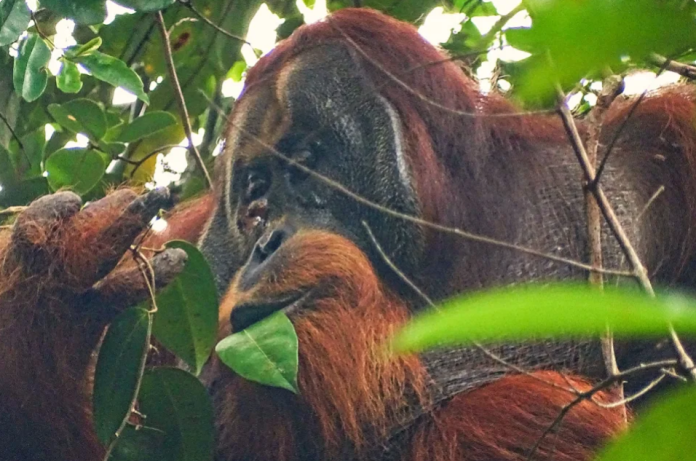An orangutan named Rakus hit a rough patch in the summer of 2022.
Researchers heard a fight between male orangutans in the treetops of a rainforest in Sumatra, Indonesia; a day later, they spotted Rakus sporting a pink wound below his right eyelid.
A chunk of flesh about the size and shape of a puzzle piece was missing. When Rakus, who is most likely in his 30s, belted out a long call, the researchers noticed another wound inside his mouth.
Over the next several days, researchers followed Rakus at a distance — and saw something so surprising they wound up reporting it in great detail in the journal Scientific Reports.
According to their study, published Thursday, Rakus was observed repeatedly chewing on the leaves of a particular liana plant over several days. The climbing vine is not a typical food for orangutans, but it is known to humans as a pain reliever.
On at least one occasion, Rakus made a paste from the chewed leaves and applied it to his face. It’s the first time an animal has been seen applying medicine to a skin wound.
“It’s the first documentation of external self-medication — the application of leaves, I would argue, as a poultice, like humans do to treat wounds and pains,” said Michael Huffman, an associate professor at the Wildlife Research Center at Kyoto University in Japan, who was not involved in the new study.
Rakus’ wound never showed signs of becoming infected, and it closed up within a week.
The discovery is new evidence that orangutans are able to identify and use pain-relieving plants. A growing body of research suggests other animal species also self-medicate, with varying levels of sophistication.
The researchers behind the study think that great apes’ ability to identify medicines and treat wounds could trace back to a shared ancestor with humans.
The discovery was possible only because Rakus spends his days in a protected area of rainforest called the Suaq Balimbing research area, in Indonesia’s Gunung Leuser National Park.
Researchers have been observing orangutans there since 1994. Today, about 150 call the area home. Rakus, who was first observed there in 2009, is either a resident or a frequent visitor.
Scientists often follow an individual orangutan in the area from early morning — when it leaves its night nest — until it builds a new night nest about 12 hours later.
“We don’t disturb the orangutan,” said an author of the new study, Isabelle Laumer, a primatologist and cognitive biologist at the Max Planck Institute of Animal Behavior in Germany. “They completely tolerate us following them.”
Laumer said that researchers had never before observed orangutans in the area self-medicating like Rakus did and that it was not clear how he developed the behavior.
It’s possible Rakus learned to treat his wound through “individual innovation,” Laumer said, after he accidentally touched a finger to a wound with the pain-relieving leaf juice. Or he may have learned the behavior culturally, from other orangutans, early in life.
Orangutans learn socially and have been shown to be capable with tools. They develop sophisticated knowledge of foods from their mothers.
“They learn a lot about, for example, what types of fruit to eat, where to find them, when to find them, when they are ripe, how to process them,” Laumer said.
“Some orangutans feed on up to 400 different plants. … This is quite some intensive knowledge that they actually need to acquire.”
Did humans learn about medicinal plants from animals?
Evidence of animal self-medication has mounted in recent decades.
In the 1960s, the famous primatologist Jane Goodall noticed that chimpanzees in Tanzania were eating whole leaves from a plant later identified as a type of Aspilia shrub. Decades later, Huffman wrote a paper describing how a different population of chimpanzees ate the bitter pith of a particular daisy, but only rarely and when other behaviors suggested they were sick.
Researchers think chimps developed such behaviors to treat or prevent parasites.
In the 1990s and the 2000s, a flood of research identified additional examples of self-medication.
A notable 2008 study of Bornean orangutans documented three females rubbing their bodies with a paste of chewed Dracaena cantleyi plant, which local Indigenous people use to address joint and bone pain.
Huffman said he thinks all animal species self-medicate to some degree. Researchers have even documented the practice in insects.
“It shows us that animals have control over their lives,” he said. “That they can behave in ways that are flexible, that are adaptive to certain circumstances that come down to their very survival.”
He theorized that ancient humans derived the ability to identify medicinal plants and substances from close observations of animals.
“A lot of medicine that humans have used over in our history as a species have come from our close connection with nature and looking to other animals for advice and extrapolating from what we’ve learned,” Huffman said.
“I don’t know of any plant that an animal has been documented to be using as medicine that isn’t also used by humans. And I think that it’s the humans who have learned from the animals.”
Laumer said her team’s findings — in a species that is 97% genetically similar to humans — could offer insight into how ancient primates developed their inclination to pursue medicines.
“It’s possible that our last common ancestor already showed similar forms of ointment behavior,” she said.
Laumer added that the new findings also show how much can be learned from orangutans, who are considered critically endangered. The rainforests where Sumatran orangutans live are vanishing as land is converted to agriculture and climate change intensifies wildfires.
The latest estimates, from 2016, suggest fewer than 14,000 are left.


